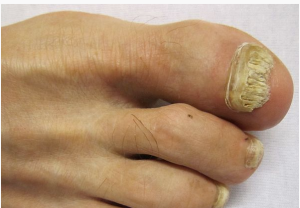Fungal nails is a common problem
If you have fungal toenails, you are not alone. It affects about 10% of the population and is the most common problem to affect your toenails.
Fungal nails also becomes more common as we become older – affecting a greater percentage of people over the age of 60.
Fungal nails can be a serious problem for people affected with poor circulation, diabetes, or those people with weakened immune systems.
Fungal nails often start at the nail salon
A fungus is actually a living organism growing on or under your nails. It can start with only one nail and eventually spread to many nails.
Fungi are everywhere, but really start to grow when it finds a warm, dark, damp area. All it takes is a nail technician to push a little too hard on the nail cuticle, or clean a little too far under the toenail to get it started. That little space under the nail can hold onto some extra moisture which opens the door for some fungus to start growing.
Fungal nails can get started by other minor injuries to the nail as well.
- Dropping something onto the toenail
- Wearing shoes that are too tight
- Stubbing your toe
- Somebody stepping on your toe
- Running for long distances
What treatments are available for fungal nails?
Treatment of fungal nails usually fall into two categories – external treatments and internal treatments.
External treatment for Fungal Nails
External treatments for fungal nails is are those things applied to the outside or on top of the toenail.
Examples of External treatments:
- Topical prescription antifungal medications (Penlac, Jublia, Kerydin)
- Removal of part or all of the toenail
- Laser treatment of the nail
Internal treatments for Fungal Nails
Internal treatments for fungal nails is are medications taken by mouth.
Examples of Internal treatments:
- Lamisil tablets
- Sporonox tablets
- Griseofulvin tablets
Why does treatment for fungus nails often not work?
Not every black toenail is a fungal nail
Since not every black or thick toenail is actually infected with a fungus, a fungal medicine may not be the answer.
The first thing to do when treating a thick, or black toenail is to identify that you actually do have fungal nails. Making sure you have the right diagnosis is important to getting the right treatment.
Re-infection is common
The fungus in the nail can get on the skin (Athlete’s Foot) which can then get back into the nail.
It’s important to treat the Athlete’s Foot at the same time to prevent re-infection.
Treatment takes a long time so people give up
It takes on average one year to clear up fungal nails. In fact, it may take a few months before you even notice a change in the nail. In the beginning, the change in the nail is so subtle, that the nail may actually be starting to get better, but since you don’t know what to look for, you may not even realize it.
This causes many people to stop applying the topical medications, or stop taking the oral medication – so they just give up.
Which treatment for fungal nails works best?
No one treatment for fungal nails is that best treatment. Fungi are very resistant to treatment and often require a combination of treatments for the best result.
Can I wear nail polish while treating fungal nails?
Yes! The newer prescription topical antifungal medications do penetrate nail polish. You will get the best result if you start applying the medication without nail polish for a while. Then, you can begin wearing nail polish while using the topical medications. It does help to take the polish off for one or two days each week to help the medicine get absorbed even more.
If you are ready to get treatment for your fungal nails, give our office a call at (845) 298-9074. We now have Tuedsay and Thursday evening appointments available.
Hollowbrook Foot Specialist serving the Hudson Valley from Wappingers Falls.
By David Schlam



